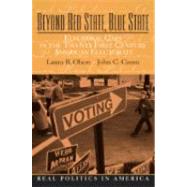
Laura R. Olson is professor of political science at Clemson University. Her research focuses on contemporary religion, civic engagement, and American politics, with special emphasis on the political attitudes and behaviors of clergy. She is the author, coauthor, or coeditor of seven books, including Religion and Politics in America: Faith, Culture, and Strategic Choices (Westview, 2004) and many scholarly articles and book chapters.
John C. Green is Distinguished Professor of political science at the University of Akron and the director of the Ray C. Bliss Institute of Applied Politics. He has done extensive research on American political parties, campaign finance, and religion and politics. An author and editor of numerous books, his most recent publications include The Faith Factor (Praeger, 2007) and The State of the Parties (Rowman & Littlefield, 2006).
| Preface | p. viii |
| About the Contributors | p. ix |
| "Gapology" and the 2004 Presidential Vote | p. 1 |
| "Gapology" and the 2004 Presidential Vote | p. 2 |
| Piecing the Gaps Together | p. 6 |
| The Plan of the Book | p. 8 |
| Notes | p. 9 |
| Racial and Ethnic Gaps | p. 10 |
| Group Identification and Group-Based Heuristics | p. 12 |
| A History of Groups in Politics | p. 13 |
| The Significance of Groups in Politics: The Case of African Americans | p. 16 |
| Group-Based Heuristics and African-American Politics | p. 18 |
| Making Sense of Heuristics | p. 19 |
| Expectations on the Future of Racial/Ethnic Electoral Gaps | p. 20 |
| Notes | p. 21 |
| The Marriage Gap | p. 24 |
| The Different Political Worlds of Married and Unmarried America | p. 25 |
| The Rise of Unmarried America and the Changing American Family | p. 28 |
| A Tale of Two Cohorts | p. 31 |
| Causes of the Marriage Gap | p. 31 |
| Political Mobilization | p. 34 |
| The Future of the Marriage Gap and Related Research | p. 37 |
| Notes | p. 38 |
| The Worship Attendance Gap | p. 40 |
| The Sociological Roots of the Worship Attendance Gap | p. 41 |
| The Political Roots of the Worship Attendance Gap | p. 43 |
| The Emergence of the Worship Attendance Gap | p. 44 |
| The Worship Attendance Gap in 2004 | p. 46 |
| Will the Worship Attendance Gap Persist in the Future? | p. 49 |
| Notes | p. 50 |
| The Class Gap | p. 53 |
| The Development of Class Analyses | p. 55 |
| The Evidence on Class Divisions | p. 56 |
| Class Divisions in American Politics | p. 59 |
| Constraints on Class Divisions | p. 62 |
| Culture Wars and Class Divisions | p. 63 |
| Income and Abortion Views | p. 65 |
| Conclusion | p. 68 |
| Notes | p. 69 |
| The Rural-Urban Gap | p. 74 |
| Urban Voters and Democratic Loyalty | p. 78 |
| Rural Voters and Republican Loyalty | p. 79 |
| Sources of Urban-Rural Division in Place-Based Stereotypes | p. 80 |
| Economic Change and the Experience of Economic Change | p. 82 |
| Entrepreneurial Self-Images and Private Property | p. 83 |
| Weeding Out the Failures: Labor Market Migration | p. 87 |
| Conclusion | p. 89 |
| Notes | p. 90 |
| The Gender Gap | p. 92 |
| The History of the Modern Gender Gap: 1952 to 2004 | p. 93 |
| What Causes the Gender Gap? | p. 94 |
| Gender Differences in Political Attitudes | p. 95 |
| What Women and Men Really Care About | p. 97 |
| The Gender Gap in 2004 | p. 97 |
| Was It the Security Moms? | p. 100 |
| Conclusion | p. 106 |
| Notes | p. 107 |
| The Generation Gap | p. 109 |
| Age Groups, Socialization, and the Study of Generations | p. 109 |
| The Generation Gap in the Presidential Vote | p. 114 |
| The Generation Gap in 2004 | p. 116 |
| Explaining the Generation Gap in 2004 | p. 118 |
| Conclusion | p. 125 |
| Notes | p. 126 |
| Appendix | p. 127 |
| Targeting and Electoral Gaps | p. 129 |
| Targeting Base Supporters and Persuadable Voters | p. 130 |
| Defining Voters | p. 135 |
| Using Targeting Information | p. 139 |
| Micro-Targeting | p. 140 |
| Conclusion | p. 141 |
| Notes | p. 142 |
| Index | p. 143 |
| Table of Contents provided by Ingram. All Rights Reserved. |
The New copy of this book will include any supplemental materials advertised. Please check the title of the book to determine if it should include any access cards, study guides, lab manuals, CDs, etc.
The Used, Rental and eBook copies of this book are not guaranteed to include any supplemental materials. Typically, only the book itself is included. This is true even if the title states it includes any access cards, study guides, lab manuals, CDs, etc.